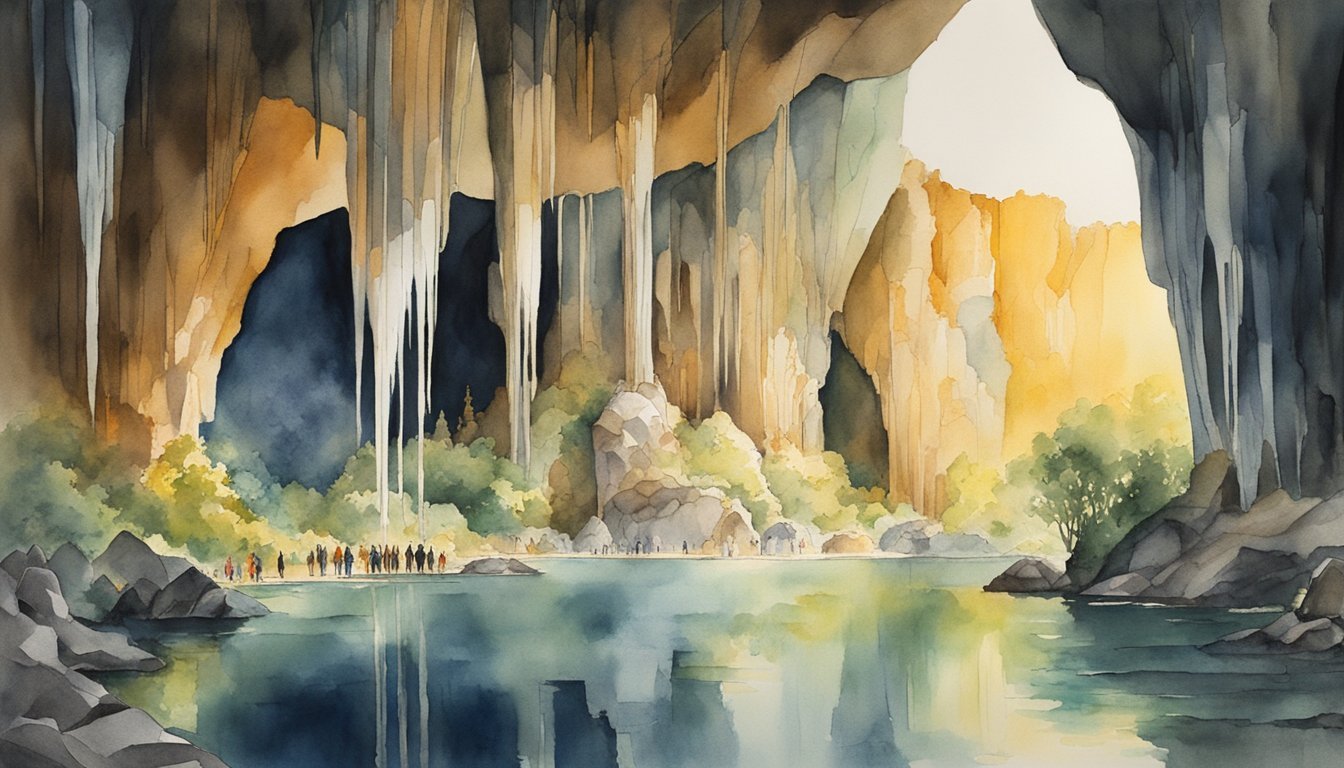Exploring the Wonders of Kentucky’s Caves
Kentucky is home to a vast array of awe-inspiring caves, each with unique features and historical significance. These subterranean landscapes offer visitors the opportunity to explore the depths of the earth and experience nature from an entirely different perspective.
Mammoth Cave National Park
Mammoth Cave National Park is renowned for having the world’s longest cave system, with more than 400 miles of surveyed passageways. This UNESCO World Heritage Site and International Biosphere Reserve offers a selection of cave tours tailored to different interests and fitness levels. The Historic Tour takes visitors through the enchanting passages and chambers that have a rich history, while the Frozen Niagara Tour showcases spectacular stalactites and stalagmites. More adventurous visitors can embark on the Wild Cave Tour, a strenuous journey through challenging and undeveloped parts of the cave.
- Tour Highlights:
- Grand Avenue Tour: A 4-hour journey through grand-scale rooms and narrow corridors.
- Wild Cave Tour: For those looking to explore the rugged and less-traveled areas of the cave.
- Self-Guided Tour: Allows visitors to explore the cave at their own pace along a well-lit pathway.
Remarkable Cave Attractions
Beyond Mammoth Cave, Kentucky boasts many other fascinating caverns. Carter Caves State Resort Park, with its history dating back to the War of 1812, offers lantern tours showcasing the park’s impressive limestone caverns. Hidden River Cave is tied to the community’s historical usage for drinking water and hydroelectricity. For those interested in geology, Crystal Onyx Cave features an abundance of delicate onyx formations that decorate the cave walls. Another remarkable site is Lost River Cave, where visitors can embark on an underground boat tour through a scenic cavern system. Additionally, Outlaw Cave provides an adventurous glimpse into the hideouts once used by infamous fugitives. For travelers intrigued by both subterranean wonders and distant adventures, the intricate rock formations found in Kentucky’s caves can inspire the same sense of discovery as Lake Baikal exploration.
- List of Tour Options:
- Lantern Tours: Experience the caves in the soft glow of a lantern, available from Memorial Day to Labor Day.
- Underground Boat Tour: Explore caves like Lost River Cave, where you can journey across an underground river.
- Educational Tours: Learn about the native American remains and historical uses of the caves throughout Kentucky’s history.
Each of these caves preserves a piece of Kentucky’s natural beauty and historical depth, offering visitors a glimpse into the subterranean realm that lies beneath the rolling hills and lush woodlands of the state.
Practical Information for Cave Visitors

Visiting the cave systems in Kentucky such as the renowned Mammoth Cave requires planning and an awareness of conservation efforts and safety protocols to ensure a fulfilling experience.
Planning Your Cave Adventure
Before setting out for Mammoth Cave National Park or any other caves in the region, visitors should check the operating hours, which can vary depending on the season, with most tours being available from Memorial Day to Labor Day. It’s advisable to reserve guided tours in advance, especially for popular choices like lantern tours, which offer a glimpse into the cave’s human history. Travelers coming from Louisville or Nashville can get to the park via I-65, following the directions to the designated visitor’s center where most tours begin.
To experience the caves, appropriate clothing is recommended; trails can be wet and muddy, and the cave’s temperature remains constant around 54 degrees Fahrenheit, so a sweatshirt or jacket and sturdy shoes are essential. Some trails are quite strenuous, involving numerous steps and steep inclines, so physical readiness is important. Visitors should remember that the cave environment is fragile; sticking to the paths and following the guidance of tour guides helps protect the natural wonder for future generations.
For those seeking a more independent exploration, self-guided tours are available at certain caves, but always verify with the owner or manager as permits may be required. For recreation outside the caves, there are campgrounds nearby, providing an excellent base for extended stays.
Conservation and Safety Measures
The protection of Kentucky’s caves is of utmost importance, with efforts focused on preserving the unique ecosystems and delicate formations they contain. As caves are natural traps for groundwater, visitors are often reminded to avoid contaminating the environment, with strict guidelines against littering or touching formations.
Safety in caves is paramount. They are inherently dark, and uneven ground and handrails covered with cave sediment can be slippery. Visitors are advised to bring a reliable flashlight or headlamp, as well as a backup light source. Cave explorers should also inform someone outside the cave of their plans and expected return time; never enter a cave alone. Notably, historic figures such as Stephen Bishop, an enslaved African American who served as one of the first tour guides for Mammoth Cave, demonstrated the importance of local knowledge and careful navigation in the cave’s early days.
It’s important to understand that activities like wild caving or exploring sinkholes and undeveloped caves are for experienced individuals and may require special permits. Participants should always follow cave conservation practices to maintain the integrity of these underground marvels.
For a more in-depth look at cave conservation and safe caving practices, refer to the guidelines provided by Mammoth Cave National Park on protecting cave ecosystems.

